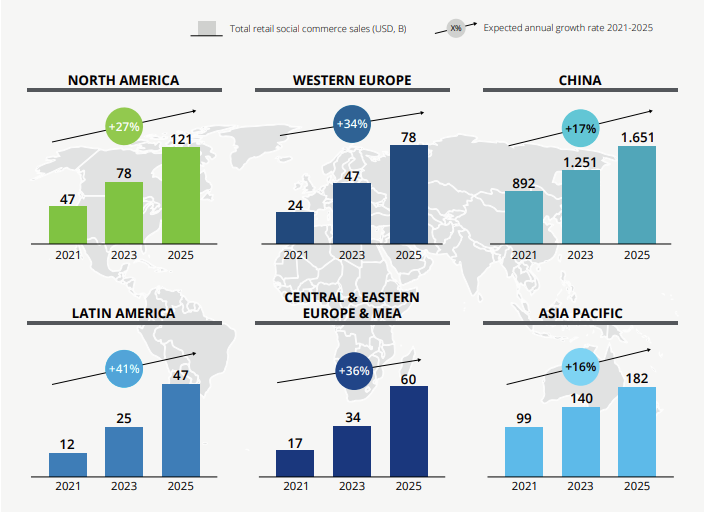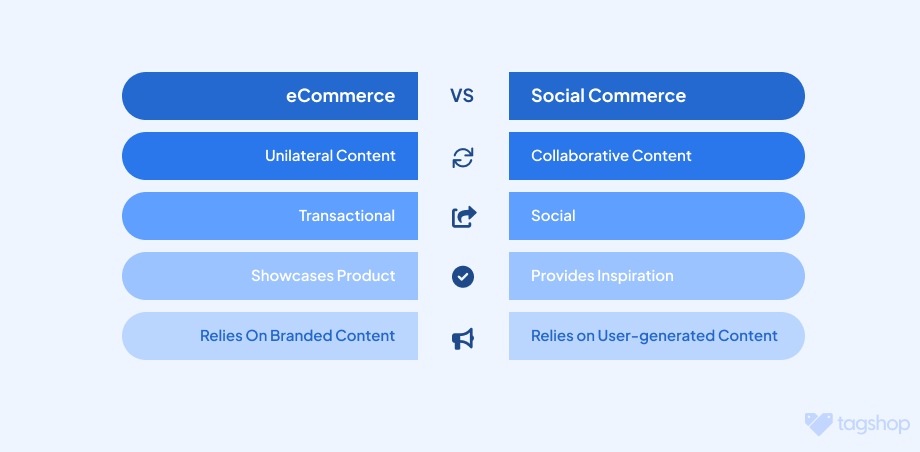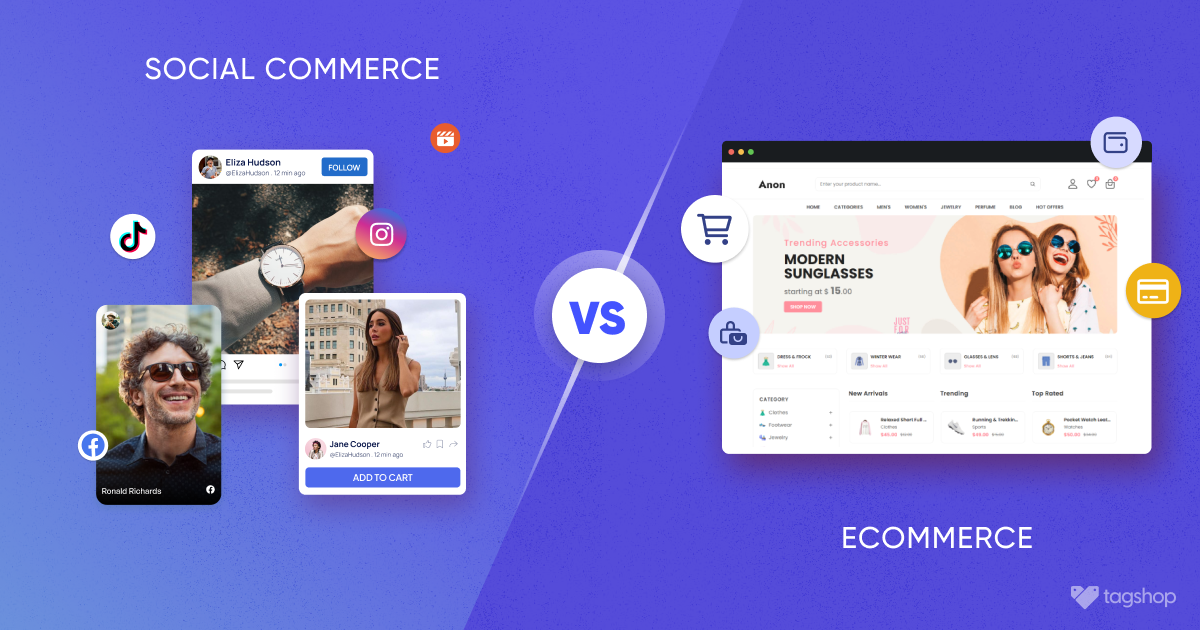The Evolution of Social Commerce: Definition & Why It’s Here To Stay
The best way to predict the future is to create it – said Abraham Lincoln. And, whoever invented social commerce must be a firm believer of this sentiment.
The evolution of social commerce certainly did not happen overnight. Even the gravitation of e-commerce took its time. e-commerce as we know it today has evolved significantly over the years, and can be traced back to 1980’s, even before the invention of the World Wide Web in 1990!
Isn’t that exciting? Especially now, when this technology has taken over the world not just in one but various forms – including Social Commerce.
But what’s important to note is the evolution of social commerce is also influenced by emerging changes in consumer behaviors.
And while we are going to unfold it all in this blog, let’s begin by understanding what Social Commerce is in definition.

Source: Deloitte
What is Social Commerce?
Simply put, social commerce is an extended term of e-commerce. This phenomenon is a seamless blend of social media and e-commerce, allowing e-commerce businesses to integrate shoppable social media capabilities into their various e-commerce touchpoints.
Social commerce enables shoppers to explore products in their most authentic light through integrated social content.
Studies show that social commerce is expected to reach approximately two trillion USD by 2025.
With that being said, it is important to note that e-commerce is an umbrella term, and social commerce is a subset of it. Statistically speaking, there are over 12 million to 24 million e-commerce sites across the entire globe.
Which brings us to another point – What sets social commerce apart from e-commerce?
Difference Between Social Commerce vs. eCommerce

Social commerce, as we know, is a derived term meaning social media electronic commerce. Although many marketers believe that both concepts go hand-in-hand, it is essential to understand that they have their differences.
Here are a few major differences between social commerce and e-commerce:
1. Platform & Integration
- eCommerce: eCommerce refers to a website or store where the buying and selling of products are performed on the website itself. An eCommerce does not rely on any other means or integrations to complete the purchasing process.
- Social Commerce: Social commerce enables businesses to sell products or services through marketing touchpoints like shoppable emails or shoppable social media. Social commerce leverages social content as a means to showcase products.

2. Control Of Content
- eCommerce: An eCommerce website or store is originally curated. The content is self-generated, and thus, the owner of the business has complete control and rights to leverage the content as required.
- Social Commerce: Social commerce, as said earlier, leverages content from social media platforms. This content can organically drive user-generated content, or content from influencer collaborations. Nevertheless, the content is owned by other individuals and before utilizing them for integrations, it is required to obtain control via rights management.
3. Shorter & Engaging Checkout
- eCommerce: eCommerce websites provide a usual procedure to their customers to finalize their purchases. Customers explore various pages to find products, and after selecting the product, the customer is redirected to a designated checkout page. At this step, they are required to fill out mandatory fields such as delivery information and finally complete the purchase.
- Social Commerce: Social commerce on the other hand is a seamless and friction-free procedure. Customers can discover products easily through integrated shoppable social content. They can get product inspiration through the engaging social content and make confident purchases in fewer steps, minimizing the cart abandonment rate for businesses.
4. Product Discovery
- eCommerce: eCommerce websites and stores are basically self-serve stores. You have to intentionally visit the app or website of a store and explore lists of products to find and buy products.
- Social Commerce: Social commerce includes engaging social content and makes product discovery 3X simpler for customers through Shop The Look capabilities. Users can come across products in action through compelling visuals in the form of UGC and take inspiration from them. This simplified product discovery is a great way to drive revenue.

5. Establishing Brand Trust
- eCommerce: Trust in eCommerce is established through customer reviews and testimonials under products. Even though social proof is a top-tier form of strategy to build trust, it is inherently on the customer to believe in the brand, with little effort or persuasion from the brand’s side.
- Social Commerce: The foundation of social commerce is solely based on authenticity and real social content. Users are not only provided social proof in the form of reviews and visual UGC but also given product inspiration to help them make confident purchases.
Social commerce can be recognized as an evolved version of e-commerce with social integrations that enhance the shopping experience. Even though eCommerce and social commerce share common elements, such as buying and selling or products through online transactions, the two have distinct differences.
Social commerce adds a social layer to commerce, improves product discovery, engagement, and recommendations through authentic content, making it one step ahead.
When Did Social Commerce Come Into Existence?
The evolution of social commerce has happened gradually over the years. Various internet giants like Yahoo! and Facebook have taken turns to introduce social commerce in their own different ways in the early 2000s.
However, one of the early examples of social commerce in practice can be associated with 2005 when Facebook and YouTube were launched. Facebook, as we know, was the largest social media platform that introduced new concepts and redefined what social means.

Soon enough, Facebook launched its marketplace and welcomed a new wave of commerce – known as social commerce today. With Facebook Marketplace, brands can list their products and enable shoppable capabilities, making it possible for users to make purchases directly within the platform.
This contributed significantly to the evolution of social commerce.
Here are some staggering statistics that prove the power of Facebook Marketplace in the evolution of social commerce:
- From January to March 2021, Facebook Shops saw an average of one million monthly global users and approx 250 million active stores worldwide.
- Over 485 million, or 16% of active users on Facebook, log in for the sole purpose of shopping on Facebook Marketplace.
- Over 1 billion people use Facebook Marketplace every month to buy or sell items.
Over 74% of Facebook Marketplace users are aged between 18 and 34 years.

How Has Social Commerce Evolved?
Social commerce has evolved from merely being a concept to becoming a way of shopping in 2023. But the evolution of social commerce doesn’t stop here. It is transforming to become an essential part of the eCommerce sphere across industries.
Let’s learn in detail about how social commerce has evolved:
1. Shoppable Social Media Galleries
Visuals are an important part of social commerce. No matter which social media platform, if the visuals are not engaging enough to capture customers’ attention, it might not generate any revenue.
However, not every brand can start selling on social media. eCommerce giants have thousands of products and styles and need to categorize them to create a better shopping experience for their customers.
This is where shoppable social media galleries come into play. By integrating shoppable galleries into an eCommerce website’s homepage or product pages, businesses can leverage the power of engaging social media content into their eCommerce website.
2. Shoppable Emails
Cart abandonment is a major problem for eCommerce businesses across industries. Researches show that customers abandon more carts than the purchases they make.
To minimize this problem, businesses use various marketing techniques, such as email marketing. But, in order to really stand out and get the customers to complete their purchases, eCommerce brands are integrating shoppable emails into their strategy.
With shoppable emails, brands can integrate shoppable posts within the email and enable users to purchase products directly.
3. Video Commerce
Consumer behaviors are changing vigorously and businesses have no choice but to mold their ways of selling accordingly. Starting from replacing pre-posed brand-generated content with compelling user-generated images to now, when video content is taking over.
Not just that, many e-commerce businesses use live video content to sell and promote products and services to an audience in real-time. This practice lets customers to see products in action, interact with and purchase them in real-time. Nowadays, most businesses use video translators to translate their product videos for reaching a broader audience.
4. Shoppable Social Ads
The inception of shoppable social ads is another strategy that backs the evolution of social commerce. Shoppable social ads are a powerful marketing tactic for e-commerce businesses to leverage the vast user base and engagement on social media platforms for direct sales.
Shoppable social ads also offer a streamlined shopping experience for users and appeal to younger generations while allowing advertising to reach a highly targeted audience. Shoppable social ads are highly effective as they blend the potential of traditional advertising with the social aspect.
Why Social Commerce Became the Destination For Shopping?
In 2025, social commerce has unequivocally emerged as the primary destination for shopping. This strategy has undergone a remarkable evolution, turning it into the most popular and trusted way to shop among consumers. What sets this strategy apart from the tradition eCommerce strategies are its easy accessibility and ability to reach the customers where they are rather than requiring them to make the efforts.
Social commerce gives customers the power to make purchases more confidently and seamlessly through strategies like shoppable galleries curated from authentic social content or shoppable emails with integrated social content.
As we move forward, the landscape of social commerce is ripe with potential for further innovation and transformation, promising an even more dynamic and personalized shopping experience in the years to come.
Ending Note
The evolution of social commerce has been nothing short of extraordinary. From starting as a concept only valid on social media platforms with limited capabilities, to now. Social commerce has truly evolved into a masterpiece strategy that is taking over eCommerce in its true sense.
With that being said, it’s clear that social commerce will continue to evolve further with more advancements waiting to happen. The possibilities seem limitless, and it’s an exciting time to be a part of this ever-evolving digital landscape.










